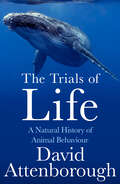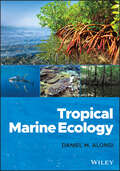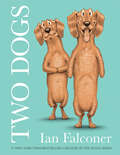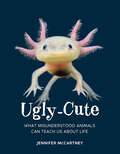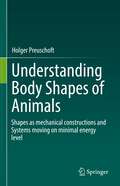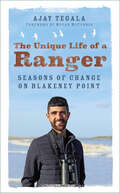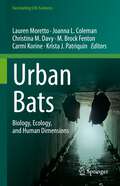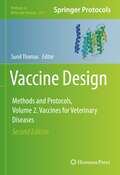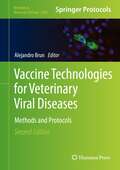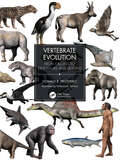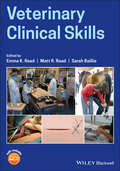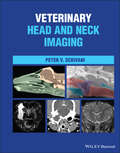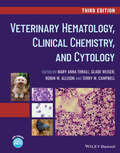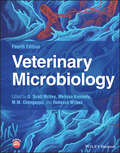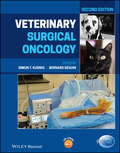- Table View
- List View
The Trials of Life: A Natural History Of Animal Behaviour
by David AttenboroughThe third and final updated edition of David Attenborough’s classic Life trilogy. Life on Earth covered evolution, Living Planet , ecology, and now The Trials of Life tackles ethology, the study of how animals behave.
Tropical Marine Ecology
by Daniel M. AlongiNo realm on Earth elicits thoughts of paradise more than the tropics. The tropical marine realm is special in myriad ways and for many reasons from seas of higher latitude, in housing iconic habitats such as coral reefs, snow white beaches, crystal clear waters, mangrove forests, extensive and rich seagrass meadows and expansive river deltas, such as the exemplar, the Amazon. But the tropics also has an even more complex side: tropical waters give rise to cyclones, hurricanes and typhoons, and unique oceanographic phenomena including the El Niño- Southern Oscillation which affects global climate patterns. Tropical Marine Ecology documents the structure and function of tropical marine populations, communities, and ecosystems in relation to environmental factors including climate patterns and climate change, and patterns of oceanographic phenomena such as tides and currents and major oceanographic features, as well as chemical and geological drivers. The book focuses on estuarine, coastal, continental shelf and open ocean ecosystems. The first part of the book deals with the climate, physics, geology, and chemistry of the tropical marine environment. The second section focuses on the origins, diversity, biogeography, and the structure and distribution of tropical biota. The third part explores the rates and patterns of primary and secondary production, and their drivers, and the characteristics of pelagic and benthic food webs. The fourth part examines how humans are altering tropical ecosystems via unsustainable fisheries, the decline and loss of habitat and fragmentation, Further, pollution is altering an earth already in the throes of climate change. Tropical Marine Ecology is an authoritative and comprehensive introduction to tropical marine ecology for advanced undergraduate and postgraduate students. It is also a rich resource and reference work for researchers and professional managers in marine science.
Tropical Marine Ecology
by Daniel M. AlongiNo realm on Earth elicits thoughts of paradise more than the tropics. The tropical marine realm is special in myriad ways and for many reasons from seas of higher latitude, in housing iconic habitats such as coral reefs, snow white beaches, crystal clear waters, mangrove forests, extensive and rich seagrass meadows and expansive river deltas, such as the exemplar, the Amazon. But the tropics also has an even more complex side: tropical waters give rise to cyclones, hurricanes and typhoons, and unique oceanographic phenomena including the El Niño- Southern Oscillation which affects global climate patterns. Tropical Marine Ecology documents the structure and function of tropical marine populations, communities, and ecosystems in relation to environmental factors including climate patterns and climate change, and patterns of oceanographic phenomena such as tides and currents and major oceanographic features, as well as chemical and geological drivers. The book focuses on estuarine, coastal, continental shelf and open ocean ecosystems. The first part of the book deals with the climate, physics, geology, and chemistry of the tropical marine environment. The second section focuses on the origins, diversity, biogeography, and the structure and distribution of tropical biota. The third part explores the rates and patterns of primary and secondary production, and their drivers, and the characteristics of pelagic and benthic food webs. The fourth part examines how humans are altering tropical ecosystems via unsustainable fisheries, the decline and loss of habitat and fragmentation, Further, pollution is altering an earth already in the throes of climate change. Tropical Marine Ecology is an authoritative and comprehensive introduction to tropical marine ecology for advanced undergraduate and postgraduate students. It is also a rich resource and reference work for researchers and professional managers in marine science.
Two Dogs
by Ian FalconerThe brilliant story of two dachshunds and their escapades by Ian Falconer, the bestselling creator of the Olivia series!
Ugly-Cute: What Misunderstood Animals Can Teach Us About Life
by Jennifer McCartneyIt’s time to shun our perfectionist society and discover the beauty in everything!
Understanding Body Shapes of Animals: Shapes as mechanical constructions and Systems moving on minimal energy level
by Holger PreuschoftThis book discusses how and why animals evolved into particular shapes. The book identifies the physical laws which decide over the evolutionary (selective) value of body shape and morphological characters. Comparing the mechanical necessities with morphological details, the author attempts to understand how evolution works, and which sorts of limitations are set by selection.The book explains morphological traits in more biomechanical detail without getting lost in physics, or in methods. Most emphasis is placed on the proximate question, namely the identification of the mechanical stresses which must be sustained by the respective body parts, when they move the body or its parts against resistance.In the first part of the book the focus is on ‘primitive’ animals and later on the emphasis shifts to highly specialized mammals. Readers will learn more about living and fossil animals.A section of the book is dedicated to human evolution but not to produce another evolutionary tree, nor to refine a former one, but to contribute to answering the question: “WHY early humans have developed their particular body shape".
The Unique Life of a Ranger: Seasons of Change on Blakeney Point
by Ajay TegalaFew people have had the privilege of living on an isolated nature reserve of international importance, their every move judged by countless critics. Young ranger Ajay Tegala, embarking on his placement at Blakeney Point aged just nineteen, would have to stand firm in the face of many challenges to protect the wildlife of one of Britain’s prime nature sites.In over 120 years, only a select few rangers have devoted their heart and soul to the wildlife of Norfolk’s Blakeney Point. Watching and learning from his predecessors, Ajay faced head-on the challenges of the elements, predators and an ever-interested public. From the excitement of monitoring the growing grey seal population, to the struggles of trying to safeguard nesting birds from a plethora of threats, in The Unique Life of a Ranger, Ajay shares the many emotions of life on the edge of land and sea with honesty and affection.
Urban Bats: Biology, Ecology, and Human Dimensions (Fascinating Life Sciences)
by Lauren Moretto Joanna L. Coleman Christina M. Davy M. Brock Fenton Carmi Korine Krista J. PatriquinThe Anthropocene is the “age of human influence”, an epoch well known for its urban impact. More than half of all people already live in cities, and this proportion is expected to rise to almost 70 percent by 2050. Like other species in urban areas, bats must contend with the pressures of profound and irreversible land cover change and overcome certain unique challenges, such as the high density of roads, lights, glass, and free-ranging domestic animals. Research on urban bats in recent decades indicates that when it comes to urban life, some bats are synanthropes. In other words, although most species of bats are negatively impacted by urbanisation, many appear to not only succeed, but also thrive in cities and towns. This observation has inspired interesting questions about bats in relation to urbanisation. Which traits and behaviours equip bats for urban success? What features of urban areas increase the likelihood that bats will successfully persist there or even colonize new areas? And how does the success of urban bats affect co-habiting humans?Our book explores the interactions between bats and urban environments through case studies and reviews. Understanding how different species interact with urban environments can reveal potential opportunities to mitigate urban threats to bats and threats posed by bats to other urban organisms, including humans. With this book, we thus aspire to provide a knowledge base to help guide current and future efforts to conserve bats.
Vaccine Design: Methods and Protocols, Volume 2. Vaccines for Veterinary Diseases (Methods in Molecular Biology #2411)
by Sunil ThomasThis volume provides a practical guide providing step-by-step protocol to explore vaccines for farm and companion animals, as well as for fish and insects. Divided into three volumes, Volume 2: Vaccines for Veterinary Diseases guides readers through veterinary vaccines, vaccines for poultry, vaccines for farm animals, and vaccines for veterinary parasites. Written in the format of the highly successful Methods in Molecular Biology series, each chapter includes an introduction to the topic, lists necessary materials and reagents, includes tips on troubleshooting and known pitfalls, and step-by-step, readily reproducible protocols. Authoritative and practical, Vaccine Design: Methods and Protocols, Second Edition, Volume 2: Vaccines for Veterinary Diseases aims to be a useful practical guide to researchers to help further their study in this field.
Vaccine Technologies for Veterinary Viral Diseases: Methods and Protocols (Methods in Molecular Biology #2465)
by Alejandro BrunThis second edition includes a collection of antigen production and delivery strategies for vaccine development in veterinary species. New and updated chapters guide readers through protocols for antigen production, experimental antigen delivery and the analysis of immune responses upon vaccination. Written in the format of the highly successful Methods in Molecular Biology series, each chapter includes an introduction to the topic, lists necessary materials and reagents, includes tips on troubleshooting and known pitfalls, and step-by-step, readily reproducible protocols. Authoritative and cutting-edge, Vaccine Technologies for Veterinary Viral Diseases: Methods and Protocols, Second Edition aims to be a useful and practical guide to researches to help further their study in this field.
Vertebrate Evolution: From Origins to Dinosaurs and Beyond
by Donald R. ProtheroThe first vertebrate animals appear in the fossil record over 520 million years ago. These lineages diversified and eventually crept ashore leading to further evolutionary divergence and the appearance of the familiar charismatic vertebrates of today. From the tiniest fishes, diminutive salamanders, and miniaturized lizards to gargantuan dinosaurs, enormous brontotheres, and immense whales, vertebrates have captured the imagination of the lay public as well as the most erudite academics. They are the among the best studied organisms. This book employs beautifully rendered illustrations of these diverse lineages along with informative text to document a rich evolutionary history. The prolific and best-selling author reveals much of the latest findings regarding the phylogenetic history of vertebrates without overwhelming the reader with pedantry and excessive jargon. Simultaneously, comprehensive and authoritative while being approachable and lucid, this book should appeal to both the scholar, the student, and the fossil enthusiast. Key Features Provides an up-to-date account of evolution of vertebrates Includes numerous beautiful color reconstructions of prehistoric vertebrates Describes extinct vertebrates and their evolutionary history Discusses and illustrates the first vertebrates, as well as familiar lineages of fishes, amphibians, reptiles, birds, and mammals Reviews mass extinctions and other important events in the diversification of vertebrates Related Titles Bard, J. Evolution: The Origins and Mechanisms of Diversity (ISBN 9780367357016) Böhmer, C., et al. Atlas of Terrestrial Mammal Limbs (ISBN 9781138705906) Diogo, R., et al. Muscles of Chordates: Development, Homologies, and Evolution (ISBN 9781138571167) Schweitzer, M. H., et al. Dinosaurs: How We Know What We Know (ISBN 9780367563813)
Vertebrate Evolution: From Origins to Dinosaurs and Beyond
by Donald R. ProtheroThe first vertebrate animals appear in the fossil record over 520 million years ago. These lineages diversified and eventually crept ashore leading to further evolutionary divergence and the appearance of the familiar charismatic vertebrates of today. From the tiniest fishes, diminutive salamanders, and miniaturized lizards to gargantuan dinosaurs, enormous brontotheres, and immense whales, vertebrates have captured the imagination of the lay public as well as the most erudite academics. They are the among the best studied organisms. This book employs beautifully rendered illustrations of these diverse lineages along with informative text to document a rich evolutionary history. The prolific and best-selling author reveals much of the latest findings regarding the phylogenetic history of vertebrates without overwhelming the reader with pedantry and excessive jargon. Simultaneously, comprehensive and authoritative while being approachable and lucid, this book should appeal to both the scholar, the student, and the fossil enthusiast. Key Features Provides an up-to-date account of evolution of vertebrates Includes numerous beautiful color reconstructions of prehistoric vertebrates Describes extinct vertebrates and their evolutionary history Discusses and illustrates the first vertebrates, as well as familiar lineages of fishes, amphibians, reptiles, birds, and mammals Reviews mass extinctions and other important events in the diversification of vertebrates Related Titles Bard, J. Evolution: The Origins and Mechanisms of Diversity (ISBN 9780367357016) Böhmer, C., et al. Atlas of Terrestrial Mammal Limbs (ISBN 9781138705906) Diogo, R., et al. Muscles of Chordates: Development, Homologies, and Evolution (ISBN 9781138571167) Schweitzer, M. H., et al. Dinosaurs: How We Know What We Know (ISBN 9780367563813)
Veterinary Clinical Skills
by Rangabhashiyam Selvasembian Pardeep SinghVeterinary Clinical Skills Provides instructors and students with clear guidance on best practices for clinical skills education Veterinary Clinical Skills provides practical guidance on learning, teaching, and assessing essential clinical skills, techniques, and procedures in both educational and workplace environments. Thorough yet concise, this evidence-based resource features sample assessments, simple models for use in teaching, and numerous examples demonstrating the real-world application of key principles and evidence-based approaches. Organized into nine chapters, the text explains what constitutes a clinical skill, explains the core clinical skills in veterinary education and how these skills are taught and practiced, describes assessment methods and preparation strategies, and more. Contributions from expert authors emphasize best practices while providing insights into the clinical skills that are needed to succeed in veterinary practice. Presenting well-defined guidelines for the best way to acquire and assess veterinary skills, this much-needed resource: Describes how to design and implement a clinical skills curriculum Identifies a range of skills vital to successful clinical practice Provides advice on how to use peer teaching and other available resources Covers veterinary OSCE (Objective Structured Clinical Examination) topics, including gowning and gloving, canine physical examination, and anesthetic machine setup and leak testing Includes sample models for endotracheal intubation, dental scaling, silicone skin suturing, surgical prep, and others Emphasizing the importance of clinical skills in both veterinary curricula and in practice, Veterinary Clinical Skills is a valuable reference and guide for veterinary school and continuing education instructors and learners of all experience levels.
Veterinary Clinical Skills
by Emma K. Read Matt R. Read Sarah BaillieVeterinary Clinical Skills Provides instructors and students with clear guidance on best practices for clinical skills education Veterinary Clinical Skills provides practical guidance on learning, teaching, and assessing essential clinical skills, techniques, and procedures in both educational and workplace environments. Thorough yet concise, this evidence-based resource features sample assessments, simple models for use in teaching, and numerous examples demonstrating the real-world application of key principles and evidence-based approaches. Organized into nine chapters, the text explains what constitutes a clinical skill, explains the core clinical skills in veterinary education and how these skills are taught and practiced, describes assessment methods and preparation strategies, and more. Contributions from expert authors emphasize best practices while providing insights into the clinical skills that are needed to succeed in veterinary practice. Presenting well-defined guidelines for the best way to acquire and assess veterinary skills, this much-needed resource: Describes how to design and implement a clinical skills curriculum Identifies a range of skills vital to successful clinical practice Provides advice on how to use peer teaching and other available resources Covers veterinary OSCE (Objective Structured Clinical Examination) topics, including gowning and gloving, canine physical examination, and anesthetic machine setup and leak testing Includes sample models for endotracheal intubation, dental scaling, silicone skin suturing, surgical prep, and others Emphasizing the importance of clinical skills in both veterinary curricula and in practice, Veterinary Clinical Skills is a valuable reference and guide for veterinary school and continuing education instructors and learners of all experience levels.
Veterinary Head and Neck Imaging
by Peter V. ScrivaniVETERINARY HEAD AND NECK IMAGING A complete, all-in-one resource for head and neck imaging in dogs, cats, and horses Veterinary Head and Neck Imaging is a comprehensive reference for the diagnostic imaging of the head and neck in dogs, cats, and horses. The book provides a multimodality, comparative approach to neuromusculoskeletal, splanchnic, and sense organ imaging. It thoroughly covers the underlying morphology of the head and neck and offers an integrated approach to understanding image interpretation. Each chapter covers a different area and discusses developmental anatomy, gross anatomy, and imaging anatomy, as well as the physical limitations of different modalities and functional imaging. Commonly encountered diseases are covered at length. Veterinary Head and Neck Imaging includes all relevant information from each modality and discusses multi-modality approaches. The book also includes: A thorough introduction to the principles of veterinary head and neck imaging, including imaging technology, interpretation principles, and the anatomic organization of the head and neck Comprehensive explorations of musculoskeletal system and intervertebral disk imaging, including discussions of degenerative diseases, inflammation, and diskospondylitis Practical discussions of brain, spinal cord, and cerebrospinal fluid and meninges imaging, including discussions of trauma, vascular, and neoplastic diseases In-depth treatments of peripheral nerve, arterial, venous and lymphatic, respiratory, and digestive system imaging Veterinary Head and Neck Imagingis a must-have resource for veterinary imaging specialists and veterinary neurologists, as well as for general veterinary practitioners with a particular interest in head and neck imaging.
Veterinary Head and Neck Imaging
by Peter V. ScrivaniVETERINARY HEAD AND NECK IMAGING A complete, all-in-one resource for head and neck imaging in dogs, cats, and horses Veterinary Head and Neck Imaging is a comprehensive reference for the diagnostic imaging of the head and neck in dogs, cats, and horses. The book provides a multimodality, comparative approach to neuromusculoskeletal, splanchnic, and sense organ imaging. It thoroughly covers the underlying morphology of the head and neck and offers an integrated approach to understanding image interpretation. Each chapter covers a different area and discusses developmental anatomy, gross anatomy, and imaging anatomy, as well as the physical limitations of different modalities and functional imaging. Commonly encountered diseases are covered at length. Veterinary Head and Neck Imaging includes all relevant information from each modality and discusses multi-modality approaches. The book also includes: A thorough introduction to the principles of veterinary head and neck imaging, including imaging technology, interpretation principles, and the anatomic organization of the head and neck Comprehensive explorations of musculoskeletal system and intervertebral disk imaging, including discussions of degenerative diseases, inflammation, and diskospondylitis Practical discussions of brain, spinal cord, and cerebrospinal fluid and meninges imaging, including discussions of trauma, vascular, and neoplastic diseases In-depth treatments of peripheral nerve, arterial, venous and lymphatic, respiratory, and digestive system imaging Veterinary Head and Neck Imagingis a must-have resource for veterinary imaging specialists and veterinary neurologists, as well as for general veterinary practitioners with a particular interest in head and neck imaging.
Veterinary Hematology, Clinical Chemistry, and Cytology
by Mary Anna ThrallA clear and concise guide to veterinary laboratory diagnostic techniques and interpretation The newly revised Third Edition of Veterinary Hematology, Clinical Chemistry, and Cytology delivers a thorough and focused exploration of the basic principles of veterinary lab testing and diagnosis, as well as the cytology, hematology, and chemistry of common domestic and non-domestic species. The book offers readers an expanded wealth of clinical case presentations, providing case data and narrative discussions designed to promote skill development. The book is packed with information useful to veterinary students, technicians, pathologists, and researchers, and includes access to a companion website that offers clinical cases and the figures from the book in PowerPoint. Heavily and clearly illustrated, with a strong practical emphasis, this latest edition includes a brand-new section on veterinary cytology and a chapter on laboratory diagnosis of infectious diseases as well as updated information throughout that keeps pace with the rapidly developing field of clinical pathology. The book includes: A comprehensive overview of laboratory testing and diagnosis principles, with unique emphases on interpretive perspectives and slide preparation techniques. A complete treatment of hematopathology of domestic animal species, organized by erythrocytes, leukocytes, platelets, bone marrow, hemostasis, and transfusion medicine. A comprehensive treatment of clinical biochemistry in domestic animals organized by organ system, including electrochemical evaluation of electrolyte and acid-base pathology. A complete treatment of domestic animal cytology organized by both common collection sites and principles of inflammation, infectious agents, and neoplasia. Complete sections covering practical treatment of hematology and clinical biochemistry of non-domestic mammals, birds, reptiles, fish, and amphibians.Veterinary Hematology, Clinical Chemistry, and Cytology is a one-stop reference on veterinary laboratory diagnostic techniques and interpretation ideally suited for veterinary students, veterinary technicians, general practitioners, and specialists.
Veterinary Hematology, Clinical Chemistry, and Cytology
by Mary Anna Thrall Glade Weiser Robin W. Allison Terry W. CampbellA clear and concise guide to veterinary laboratory diagnostic techniques and interpretation The newly revised Third Edition of Veterinary Hematology, Clinical Chemistry, and Cytology delivers a thorough and focused exploration of the basic principles of veterinary lab testing and diagnosis, as well as the cytology, hematology, and chemistry of common domestic and non-domestic species. The book offers readers an expanded wealth of clinical case presentations, providing case data and narrative discussions designed to promote skill development. The book is packed with information useful to veterinary students, technicians, pathologists, and researchers, and includes access to a companion website that offers clinical cases and the figures from the book in PowerPoint. Heavily and clearly illustrated, with a strong practical emphasis, this latest edition includes a brand-new section on veterinary cytology and a chapter on laboratory diagnosis of infectious diseases as well as updated information throughout that keeps pace with the rapidly developing field of clinical pathology. The book includes: A comprehensive overview of laboratory testing and diagnosis principles, with unique emphases on interpretive perspectives and slide preparation techniques. A complete treatment of hematopathology of domestic animal species, organized by erythrocytes, leukocytes, platelets, bone marrow, hemostasis, and transfusion medicine. A comprehensive treatment of clinical biochemistry in domestic animals organized by organ system, including electrochemical evaluation of electrolyte and acid-base pathology. A complete treatment of domestic animal cytology organized by both common collection sites and principles of inflammation, infectious agents, and neoplasia. Complete sections covering practical treatment of hematology and clinical biochemistry of non-domestic mammals, birds, reptiles, fish, and amphibians.Veterinary Hematology, Clinical Chemistry, and Cytology is a one-stop reference on veterinary laboratory diagnostic techniques and interpretation ideally suited for veterinary students, veterinary technicians, general practitioners, and specialists.
Veterinary Microbiology
by D. Scott McVey Melissa Kennedy Rebecca Wilkes M. M. ChengappaVeterinary Microbiology Comprehensive reference work on the bacterial, fungal, and viral pathogens that cause animal diseases Veterinary Microbiology, Fourth Edition presents comprehensive information based on the most recent research, diagnostic, and clinical publications for bacterial, fungal, and viral animal diseases. The information provided is intended to be most relevant for veterinary students and practitioners. The text is supported throughout by high-quality and full-color images to aid learning. A companion website offers chapter content, supplemental information, and figures from the book in PowerPoint format. Sample topics discussed within the book include: Pathogenic bacteriology: includes major classifications and genera of bacteria associated with veterinary infectious disease Pathogenic mycology: dermatophytes, agents of subcutaneous mycoses, and agents of systemic mycoses Pathogenic virology: includes RNA and DNA viruses as well as prions associated with veterinary infectious disease
Veterinary Microbiology
by D. Scott McVey Melissa Kennedy M. M. Chengappa Rebecca WilkesVeterinary Microbiology Comprehensive reference work on the bacterial, fungal, and viral pathogens that cause animal diseases Veterinary Microbiology, Fourth Edition presents comprehensive information based on the most recent research, diagnostic, and clinical publications for bacterial, fungal, and viral animal diseases. The information provided is intended to be most relevant for veterinary students and practitioners. The text is supported throughout by high-quality and full-color images to aid learning. A companion website offers chapter content, supplemental information, and figures from the book in PowerPoint format. Sample topics discussed within the book include: Pathogenic bacteriology: includes major classifications and genera of bacteria associated with veterinary infectious disease Pathogenic mycology: dermatophytes, agents of subcutaneous mycoses, and agents of systemic mycoses Pathogenic virology: includes RNA and DNA viruses as well as prions associated with veterinary infectious disease
Veterinary Ophthalmic Surgery - E-Book
by Kirk N. Gelatt Janice P. Gelatt Caryn PlummerVeterinary Ophthalmic Surgery - E-Book
Veterinary Surgical Oncology
by Simon T. Kudnig Bernard SéguinVETERINARY SURGICAL ONCOLOGY The new edition of the most comprehensive resource on surgical oncology, covering both basic and advanced surgical oncology procedures in small animals Veterinary Surgical Oncology is a detailed, highly illustrated reference to surgical treatment of cancer in small animal patients. Designed to provide in-depth coverage of surgical procedures, the book also includes useful information on diagnostic testing, complications, aftercare, outcomes, prognosis, and adjuvant or alternative therapies to assist veterinary surgeons and veterinary oncologists with decision making. Contributions by leaders in the field discuss the principles of surgical oncology, multimodal therapy, and interventional radiology, and describe surgical techniques in all anatomical structures. Now in its second edition, Veterinary Surgical Oncology is fully revised and incorporates new material, including a brand-new chapter discussing the anatomic, functional, and ethical limits of surgical oncology procedures. This edition contains expanded coverage of interventional oncology with discussion of these techniques in relevant chapters, additional surgical procedures, as well as more information regarding other modalities, including extravasation of chemotherapy and the effects of chemotherapy and radiation therapy on wound healing. Additional surgical procedures are supported by new figures, improved images, and up-to-date information. This authoritative surgical oncologic textbook: Emphasizes a multidisciplinary approach to cancer treatment that integrates diagnostic imaging, chemotherapy, radiation therapy, alternative therapies, and cancer biology Provides new and expanded sections by specialist medical oncologists, surgeons, and a specialist neurologist that cover all the latest advances in the field Includes more than 800 high-quality images and illustrations Features a new companion website with videos Veterinary Surgical Oncology, Second Edition remains essential reading for all practicing veterinarians, as well as specialists and trainees in veterinary surgery, oncology, and internal medicine.
Veterinary Surgical Oncology
by Simon T. Kudnig Bernard SéguinVETERINARY SURGICAL ONCOLOGY The new edition of the most comprehensive resource on surgical oncology, covering both basic and advanced surgical oncology procedures in small animals Veterinary Surgical Oncology is a detailed, highly illustrated reference to surgical treatment of cancer in small animal patients. Designed to provide in-depth coverage of surgical procedures, the book also includes useful information on diagnostic testing, complications, aftercare, outcomes, prognosis, and adjuvant or alternative therapies to assist veterinary surgeons and veterinary oncologists with decision making. Contributions by leaders in the field discuss the principles of surgical oncology, multimodal therapy, and interventional radiology, and describe surgical techniques in all anatomical structures. Now in its second edition, Veterinary Surgical Oncology is fully revised and incorporates new material, including a brand-new chapter discussing the anatomic, functional, and ethical limits of surgical oncology procedures. This edition contains expanded coverage of interventional oncology with discussion of these techniques in relevant chapters, additional surgical procedures, as well as more information regarding other modalities, including extravasation of chemotherapy and the effects of chemotherapy and radiation therapy on wound healing. Additional surgical procedures are supported by new figures, improved images, and up-to-date information. This authoritative surgical oncologic textbook: Emphasizes a multidisciplinary approach to cancer treatment that integrates diagnostic imaging, chemotherapy, radiation therapy, alternative therapies, and cancer biology Provides new and expanded sections by specialist medical oncologists, surgeons, and a specialist neurologist that cover all the latest advances in the field Includes more than 800 high-quality images and illustrations Features a new companion website with videos Veterinary Surgical Oncology, Second Edition remains essential reading for all practicing veterinarians, as well as specialists and trainees in veterinary surgery, oncology, and internal medicine.
Veterinary Technician and Nurse's Daily Reference Guide: Canine and Feline
by Mandy Fults Kenichiro YagiThe revised and expanded new edition of this classic reference to daily skills used by veterinary technicians Veterinary Technician and Nurse’s Daily Reference Guide: Canine and Feline provides rapid access to the information veterinary technicians need in clinical practice. With an easy-to-use tabular format, the book covers diagnostic and patient care skills, diseases and conditions, preventive care, anatomy, anesthesia, and all other major areas of veterinary technician education and training. Chapters written by experienced veterinary specialists integrate charts, tables, and concise explanatory text to enable quick and efficient retrieval of information. Focusing on practical skills and knowledge, the fourth edition features extensively revised material incorporating the latest developments, evidence-based guidelines, and best practices in veterinary medicine. Brand-new chapters describe licensure and certifications in veterinary technology and discuss nursing theory and science and its relation to veterinary nursing. Expanded and updated coverage includes novel therapeutics in dermatology, vaccination standards, pain assessment and management, stress-free handling and nursing care strategies, RECOVER CPR guidelines, and more. Equally useful in the classroom and in the clinic, this popular quick-reference guide: Provides new and updated content, including coverage of advancements in diagnostic capabilities and of pharmacologic agents used in treatment and management of disease states Contains hundreds of clear illustrations and high-quality photographs Includes a comprehensive table of contents in each chapter Features a companion website with forms and worksheets, self-review questions, vocabulary flashcards, links to online resources, and PowerPoint slides Veterinary Technician and Nurse’s Daily Reference Guide: Canine and Feline, Fourth Edition remains an invaluable resource for both student and practicing veterinary technicians and nurses of all skill and experience levels.
Veterinary Technician and Nurse's Daily Reference Guide: Canine and Feline
by Mandy Fults Kenichiro YagiThe revised and expanded new edition of this classic reference to daily skills used by veterinary technicians Veterinary Technician and Nurse’s Daily Reference Guide: Canine and Feline provides rapid access to the information veterinary technicians need in clinical practice. With an easy-to-use tabular format, the book covers diagnostic and patient care skills, diseases and conditions, preventive care, anatomy, anesthesia, and all other major areas of veterinary technician education and training. Chapters written by experienced veterinary specialists integrate charts, tables, and concise explanatory text to enable quick and efficient retrieval of information. Focusing on practical skills and knowledge, the fourth edition features extensively revised material incorporating the latest developments, evidence-based guidelines, and best practices in veterinary medicine. Brand-new chapters describe licensure and certifications in veterinary technology and discuss nursing theory and science and its relation to veterinary nursing. Expanded and updated coverage includes novel therapeutics in dermatology, vaccination standards, pain assessment and management, stress-free handling and nursing care strategies, RECOVER CPR guidelines, and more. Equally useful in the classroom and in the clinic, this popular quick-reference guide: Provides new and updated content, including coverage of advancements in diagnostic capabilities and of pharmacologic agents used in treatment and management of disease states Contains hundreds of clear illustrations and high-quality photographs Includes a comprehensive table of contents in each chapter Features a companion website with forms and worksheets, self-review questions, vocabulary flashcards, links to online resources, and PowerPoint slides Veterinary Technician and Nurse’s Daily Reference Guide: Canine and Feline, Fourth Edition remains an invaluable resource for both student and practicing veterinary technicians and nurses of all skill and experience levels.
